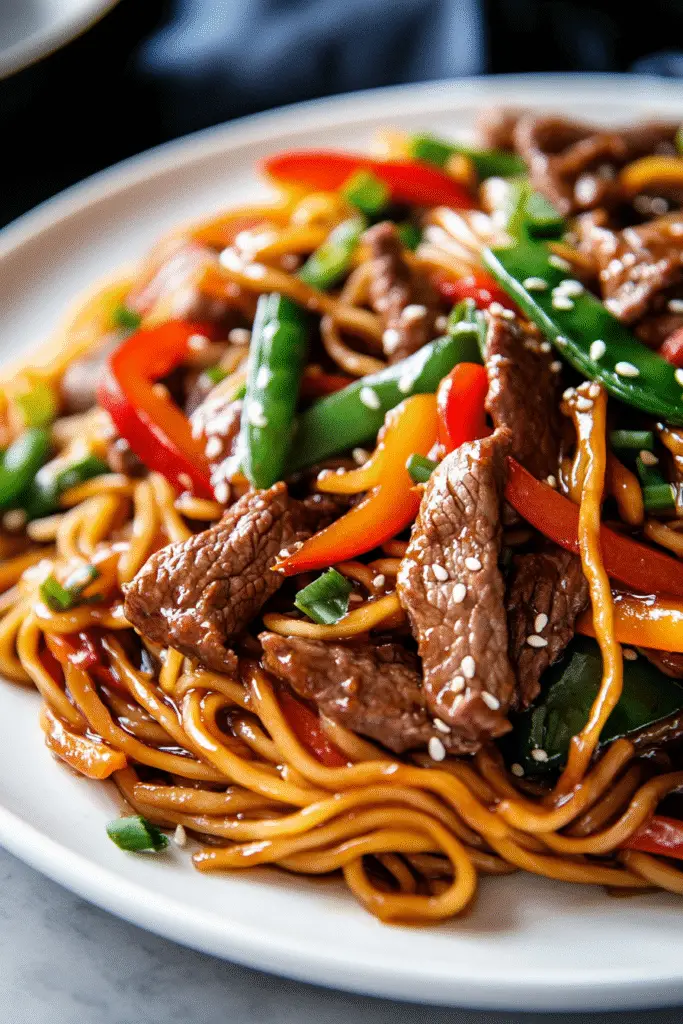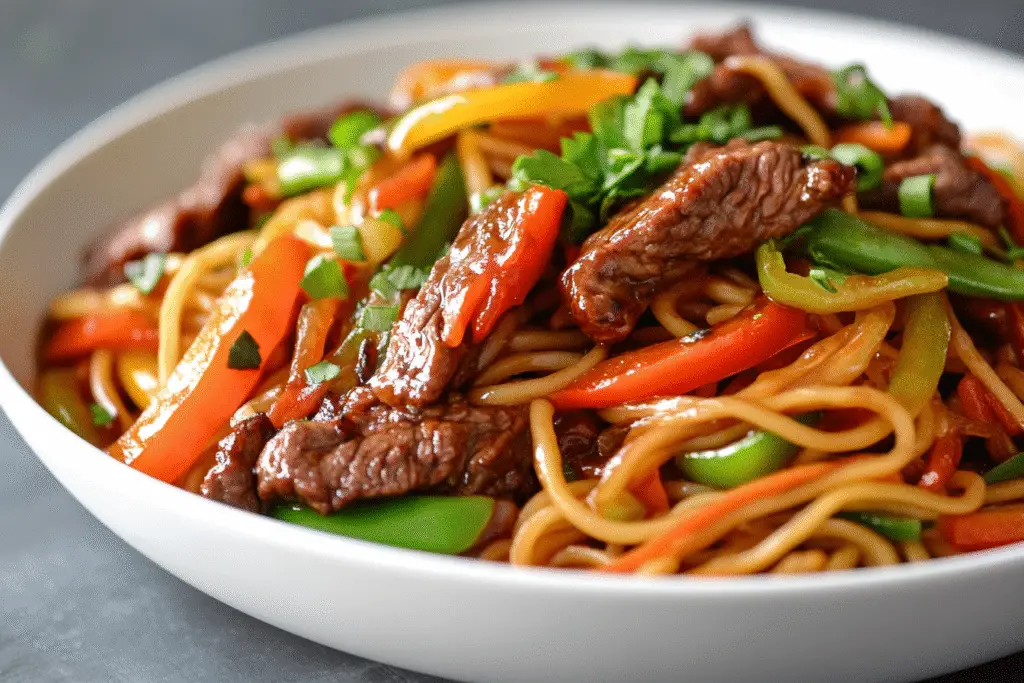Beef lo mein is a beloved Chinese-American dish that combines tender slices of beef, savory noodles, crisp vegetables, and a rich, glossy sauce. It’s hearty, satisfying, and surprisingly quick to prepare. If you’ve ever ordered lo mein from your favorite takeout spot and wondered if you could replicate that delicious texture and flavor at home, the answer is a resounding yes—with a few essential techniques and the right ingredients.
This Beef Lo Mein Recipe will guide you through every step, from selecting the best noodles and beef cuts to achieving that perfect saucy noodle coating and a crisp-tender vegetable balance. Whether you’re making it for a speedy weeknight dinner or craving a homemade version of your takeout favorite, this recipe has you covered.
Why Beef Lo Mein Can Go Wrong: Common Pitfalls and How to Avoid Them
Beef lo mein may seem straightforward, but home cooks often encounter some common issues:
- Beef that turns gray or tough instead of tender and browned.
- Overcooked noodles that turn soggy.
- Sauce that’s too thin, too salty, or doesn’t cling to the noodles.
- Vegetables that lose their crunch or get overcooked.
The good news is these mistakes are easily preventable. The keys to success are:
- Proper slicing and marinating of the beef.
- Pre-cooking the noodles to al dente and rinsing them to prevent sticking.
- Building a sauce that’s thick enough to coat the noodles.
- Cooking everything over high heat and working quickly.
Beef lo mein is all about preparation and fast cooking. Once your ingredients are prepped, the dish comes together in under 10 minutes.

Choosing the Right Ingredients for Authentic Flavor and Texture
Noodles
- Lo mein noodles: Egg noodles specifically labeled as “lo mein” are the best choice for the perfect chew.
- Alternatives: Fresh Chinese egg noodles, yakisoba noodles, or even spaghetti if you can’t find traditional lo mein noodles.
Tip: Cook noodles to al dente, rinse under cold water, and toss with a little oil to prevent clumping.
Beef Selection
- Best cuts: Flank steak, skirt steak, or sirloin—all tender cuts that cook quickly.
- Avoid: Stewing cuts like chuck or round that require long cooking.
Tip: Slice thinly against the grain to ensure tenderness.
Vegetables
- Classic lo mein vegetables include:
- Carrots (julienned)
- Bell peppers (thinly sliced)
- Snow peas
- Bean sprouts
- Green onions
- Broccoli (optional)
Tip: Cut all vegetables uniformly for even cooking.
Sauce Ingredients
- Soy sauce (regular or low-sodium)
- Oyster sauce (adds savory depth)
- Hoisin sauce (sweet and savory balance)
- Sesame oil (for aroma)
- Cornstarch slurry (to thicken the sauce)

Essential Equipment for Beef Lo Mein
- Wok or large skillet: A wok provides high heat and easy tossing, but a wide, heavy skillet works fine.
- Tongs or a large spatula: To toss noodles quickly and evenly.
- Sharp knife: For precise, thin slices of beef and vegetables.
If you enjoy making stir-fry or noodle dishes regularly, investing in a wok is highly recommended.
Smart Preparation Tips for Success
Preparation is critical because lo mein cooks very quickly once you start.
Prep Checklist:
- Beef: Slice and marinate before you cook.
- Vegetables: Chop and organize in bowls.
- Noodles: Cook, rinse, and lightly oil in advance.
- Sauce: Mix all sauce components in a bowl beforehand.
The actual stir-frying process takes less than 10 minutes, so having everything ready and within reach is essential.
Flavor Variations and Substitutions
- Spicy: Add sriracha, chili oil, or red pepper flakes to the sauce.
- Sweeter: Increase hoisin sauce or add a teaspoon of brown sugar.
- Vegetarian: Omit beef and add more vegetables or use tofu.
- Low-carb: Substitute with spiralized zucchini or shirataki noodles.
You can also swap the beef for chicken, shrimp, or even pork using the same marinade and stir-fry method.
Common Mistakes and How to Fix Them
- Beef turns gray: The pan wasn’t hot enough, or you overcrowded it. Sear in batches over high heat.
- Noodles are mushy: Overcooking is the usual culprit. Cook to al dente and rinse under cold water immediately.
- Sauce is watery: The cornstarch slurry wasn’t added or cooked long enough to thicken.
- Vegetables are soggy: Stir-fry over high heat quickly to retain crispness.
Storage, Freezing, and Reheating Tips
- Storage: Beef lo mein keeps well in the refrigerator for up to 3 days in an airtight container.
- Reheating: Best reheated in a skillet over medium heat with a splash of water or broth to loosen the sauce. Microwave in short intervals, stirring between bursts.
- Freezing: Not recommended as noodles can become mushy and vegetables lose texture upon thawing.
Beef Lo Mein Recipe
Ingredients
For the Beef:
- ¾ pound flank steak, thinly sliced against the grain
- 1 tablespoon soy sauce
- 1 tablespoon cornstarch
- 1 teaspoon sesame oil
For the Sauce:
- ¼ cup soy sauce
- 2 tablespoons oyster sauce
- 1 tablespoon hoisin sauce
- ½ teaspoon sugar
- ½ teaspoon sesame oil
- ¼ cup water or beef broth
- 1 teaspoon cornstarch
For the Stir Fry:
- 12 ounces lo mein noodles (or fresh egg noodles)
- 2 tablespoons vegetable oil, divided
- 2 cups mixed vegetables (carrots, bell peppers, snow peas, broccoli)
- 3 green onions, sliced
- 2 cloves garlic, minced
- Optional: Bean sprouts for garnish
Step-by-Step Instructions
Step 1: Marinate the Beef
- In a bowl, toss the beef slices with soy sauce, cornstarch, and sesame oil.
- Let marinate for 10-15 minutes while you prep the other ingredients.
Step 2: Prepare the Sauce
- In a small bowl, whisk together soy sauce, oyster sauce, hoisin sauce, sugar, sesame oil, water, and cornstarch until smooth. Set aside.
Step 3: Cook the Noodles
- Cook lo mein noodles according to package instructions until al dente.
- Drain, rinse under cold water, and toss with a small amount of oil to prevent sticking.
Step 4: Sear the Beef
- Heat 1 tablespoon of oil in a wok or large skillet over high heat.
- Add beef in a single layer and sear for about 1-2 minutes per side until just browned. Remove and set aside.
Step 5: Stir Fry the Vegetables
- Add remaining oil to the pan.
- Stir fry garlic for 30 seconds until fragrant.
- Add carrots, bell peppers, snow peas, and broccoli. Stir fry for 2-3 minutes until crisp-tender.
Step 6: Combine Noodles, Beef, and Sauce
- Add cooked noodles and beef back to the pan.
- Pour the sauce over the noodles.
- Toss everything together over high heat for 2-3 minutes until well coated and heated through.
Step 7: Serve
- Remove from heat and garnish with sliced green onions and optional bean sprouts.
- Serve hot.
Serving Suggestions
- Classic: Serve as a complete one-pan meal.
- With sides: Pair with spring rolls, potstickers, or hot and sour soup.
- With extra heat: Serve with chili oil or sriracha on the side.
Beef Lo Mein Variations: Traditional vs. Chicken vs. Vegetarian
| Feature | Beef Lo Mein | Chicken Lo Mein | Vegetarian Lo Mein |
|---|---|---|---|
| Protein | Flank steak | Chicken breast/thigh | Tofu or extra vegetables |
| Noodles | Lo mein or egg noodles | Lo mein or egg noodles | Lo mein or egg noodles |
| Sauce | Soy, oyster, hoisin | Same | Same |
| Cook Time | ~20-25 min | ~20-25 min | ~20 min |
FAQs and Troubleshooting
Can I use spaghetti instead of lo mein noodles?
Yes, it’s a great substitute if lo mein noodles aren’t available. Cook al dente and rinse well.
Can I make this gluten-free?
Use gluten-free soy sauce (or tamari) and ensure hoisin and oyster sauces are gluten-free versions.
Why are my noodles sticking?
Toss noodles with oil after rinsing and stir-fry over high heat to keep them from clumping.
Can I make this ahead?
It’s best fresh but can be stored and reheated for up to 3 days.
How do I make this spicier?
Add chili oil, sriracha, or crushed red pepper flakes to the sauce.
Final Thoughts
Beef lo mein is a fast, satisfying, and customizable stir-fry that’s perfect for weeknight dinners. With tender beef, flavorful sauce, and perfectly cooked noodles, it rivals your favorite takeout but is quicker, more affordable, and fully under your control.
The beauty of lo mein lies in its flexibility—once you master the basic technique, you can swap in different proteins, change the vegetables, or tweak the sauce to suit your taste. Whether you’re looking for a quick dinner solution or trying to satisfy a lo mein craving, this homemade beef lo mein recipe is one you’ll come back to again and again.
